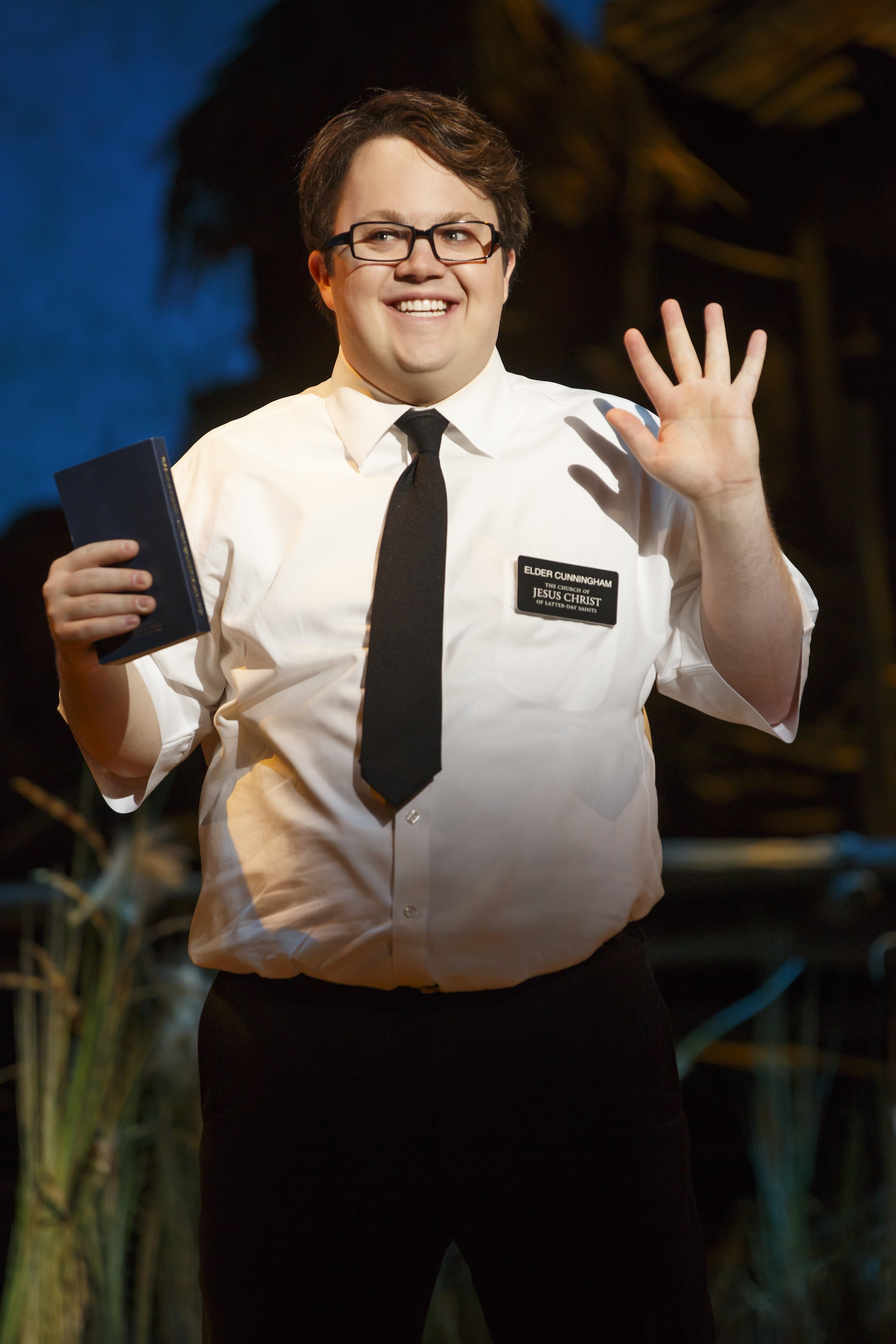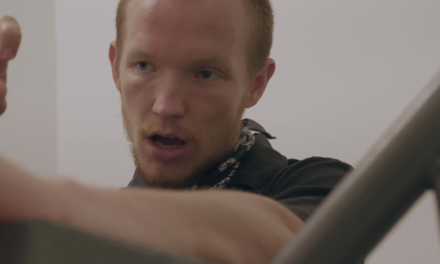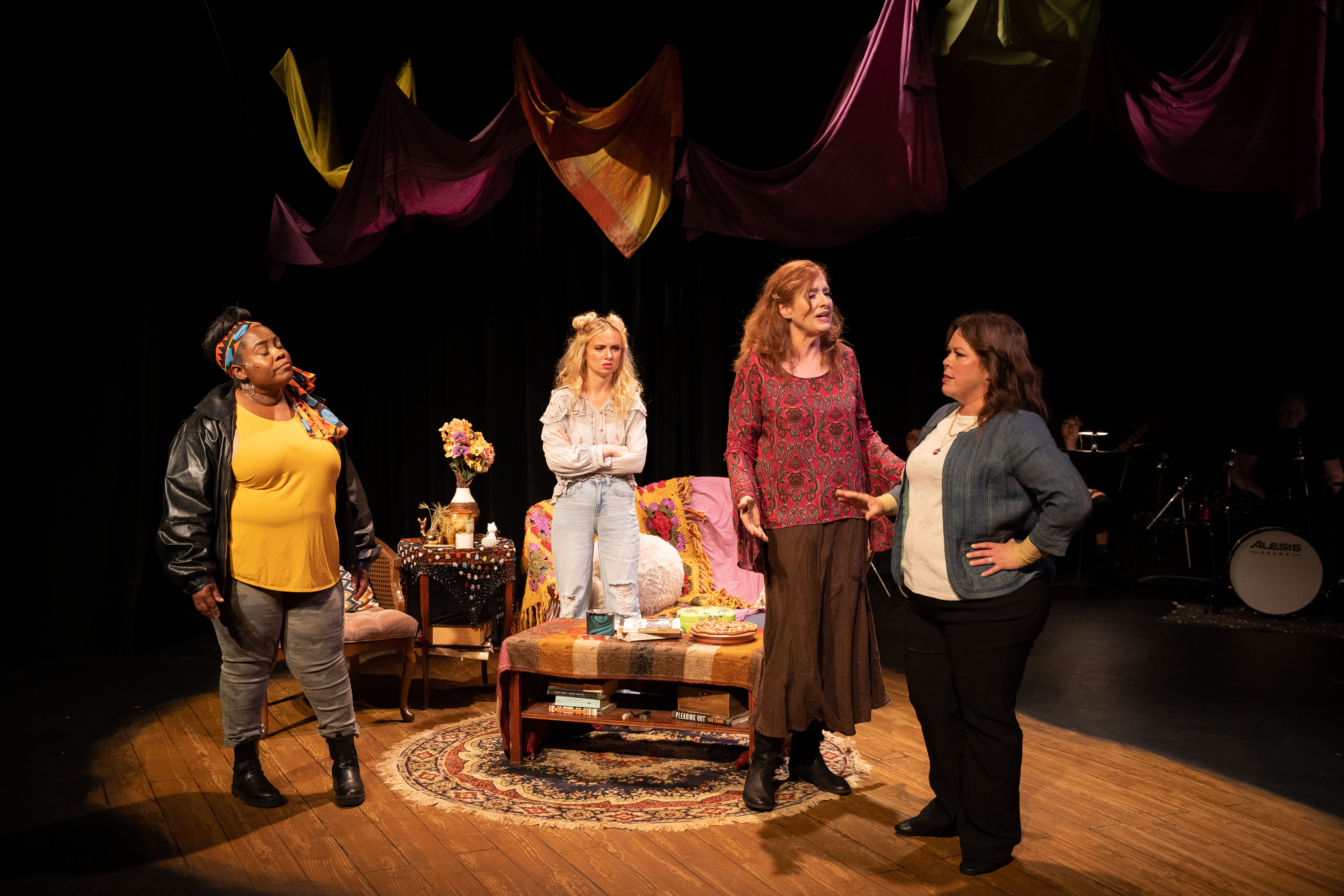Cody Jamison Strand in The Book of Mormon (c) Joan Marcus 2014.
The Book of Mormon
Book, music, & lyrics by Trey Parker, Matt Stone, & Robert Lopez
Directed by Trey Parker & Casey Nicholaw
Review by Kathi E.B. Ellis.
Entire contents are copyright © 2016 Kathi E. B. Ellis. All rights reserved
It’s been a little more than two years since Louisville audiences have seen The Book of Mormon at the Whitney, and this year it is back again with the PNC Broadway in Louisville series. The high octane combination of charm and camp continues to delight audiences, with the laughs rolling so continuously in some moments that they threaten to hold up the story.
This company has the requisite high energy needed for the irreverent dash through Mormon history and the two-year mission commitment for young men of the Church. As with any group of people there is the one destined to receive it all, Elder Price (Gabe Gibbs) and the class clown, Elder Cunningham (Cody Jamison Strand.) And then Fate steps in.
The opening of the show immediately drops the audience into a trope familiar to non-Mormons, “Hello” introduces us to the fresh-faced, smiling missionary ringing the door bell and eager to tell us about the Book of Mormon. From there we’re on to discovering where this class of young men will be assigned. Despite his desire to go to Orlando, Price is assigned to Uganda – with the mis-matched Cunningham.
After a Lion King themed send-off at the airport, where we learn that even Cunningham’s parents have low expectations of him, their arrival in Uganda is rocky, with the local warlord confiscating all their possessions. The village locals put it all in context, with “Hasa Diga Eebowai,” in which the boys are introduced to more variations of the ‘F-word’ than they could ever have imagined. But never fear, their group of missionaries led by Elder McKinley (Daxton Bloomquist) has just the right recipe for them: “Turn It Off.” And without giving too much away, the tricks of lighting and costuming in this number are brilliant. The Act Two “Spooky Mormon Hell Dream” is a fabulous phantasmagoria of red and black, hellish and hilarious, spooky and tongue in cheek – and a special acknowledgement of some wickedly fast costume changes during this number.
The ‘odd couple’ partnership of Gibbs and Strand is more strained than it needs to be; for me part of the charm of Cunningham lies in the fact that he’s only marginally aware that his dysfunction is funny, and Strand seems to be all-too-aware that he’s the comic du jour, which gets in the way of the genuinely sweet relationship with Nabalungi (Candace Quarrels.) Gibbs, who has just joined this company, plays the privileged swagger of Price at the expense of the pretty decent guy that’s part of his make-up, which makes his discovery of decency at the end more of a stretch than it needs to be.
The heart of the story lies with Nabalungi, her journey to baptism and her growing friendship with Cunningham. Quarrels has a beautiful voice which is shown to advantage in “Sal Tlay Ka Siti,” her dream of going to Salt Lake City. And her discovery that the Mormon powers-that-be dismiss the villagers’ rendition of their understanding of Cunningham’s mangled Mormon history – he’s never read the Book of Mormon – is heartbreaking. Bloomquist’s charismatic McKinley is a grand blend of exterior magnetism and repressed sexuality. David Aron Damane’s General rides a fine line of comic-book villain and a truly dangerous threat to the villagers and missionaries alike.
With book, music and lyrics written by Trey Parker, Matt Stone (of South Park fame) and Robert Lopez (Avenue Q), the whole evening is a fine line between outrageous satire and human frailty. More than five years after its opening and sweep of nine Tony Awards this deceptively traditional American Musical looks set to become a standard for years to come. A reminder that, though humor may skewer values that some hold dear, it is through humor that the other, or outsiders, can gain recognition of why others hold values different than our own. Whether Mormon or not, we can all value a need to find a meaning in the universe. The boys may have set out to do this through the Book of Mormon, but the Book of Arnold ends up doing the job much better than anyone – missionary or villager – could ever have anticipated!
As always, the impressive towers of speakers at each side of the Whitney stage mean that the lyrics, and sometimes dialogue, are overwhelmed by the music for those audience members seated directly in front of the speakers. The side sightlines from this vantage also mean that these audience members also see performers crouched behind set pieces preparing for entrances when it doesn’t make sense for them to leave stage briefly. Once again, The Book of Mormon continues its practice of not listing the musical numbers in the Audience playbill, a service that typically allows audience members to recognize and appreciate individual performers throughout the performance – and the whole company deserves such recognition.
The Book of Mormon
November 29- December 4, 2016
PNC Broadway in Louisville
Kentucky Center for the Performing Arts
501 West Main Street
Louisville, KY, 40202
502-589-7777
http://louisville.broadway.com/
Kathi E.B. Ellis is an associate member of the Stage Directors and Choreographers Society and a member of Lincoln Center and DirectorsLabChicago. She has attended the La MaMa Directing Symposium in Umbria, Italy and is featured in Southern Artisty, an online registry of outstanding southern artists. Her directing work has been recognized with nominations for South Florida theatre’s Carbonell Award. Locally, Kathi is a member of Looking for Lilith Theatre Company, a founding principal of StageLab theatre training studio, and part of ShoeString Productions, an informal producing collective. She has written book reviews and articles for Southern Theatre, the quarterly publication of the Southeastern Theatre Conference, and was a contributing writer for JCPS’ textbook for the 11th grade Arts and Humanities survey course and for YouthArts Tapestry, a Kentucky Arts Council publication.





